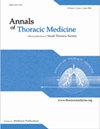在重症监护病房使用麻醉保存装置吸入镇静与静脉镇静的优势:一项系统综述
IF 2.3
4区 医学
Q3 CARDIAC & CARDIOVASCULAR SYSTEMS
引用次数: 0
摘要
摘要:背景:镇静是重症监护病房(ICU)患者管理的基础。它在ICU的适应症是广泛的,包括促进机械通气,允许侵入性手术,以及控制焦虑和躁动。使用专用设备/系统吸入卤化剂镇静,如异氟醚或七氟醚,现在在ICU患者中是可行的。与传统的静脉(IV)镇静相比,使用它可以减少不良事件并改善ICU的预后。本综述比较了ICU成人患者使用麻醉保存装置(ACD)吸入镇静与标准静脉镇静的有效性,并强调了其功能的技术方面。方法:我们检索PubMed、Cochrane中央对照试验注册库、Cochrane图书馆、MEDLINE、Web of Science和Sage期刊数据库,检索2012年至2022年间进行的随机临床研究中的“麻醉保存装置”、“Anaconda”、“镇静”和“重症监护病房”,比较使用ACD和IV镇静的挥发性镇静拔管时间、机械通气持续时间、ICU和住院时间。结果:纳入9项试验。与静脉镇静(咪达唑仑或异丙酚)相比,通过ACD给予挥发性镇静(七氟醚或异氟醚)可缩短苏醒时间。结论:与静脉镇静相比,在ICU中通过ACD给予挥发性镇静可缩短苏醒和拔管次数、ICU住院时间和机械通气时间。需要更多的临床试验来评估更多的大规模临床结果。本文章由计算机程序翻译,如有差异,请以英文原文为准。
The advantages of inhalational sedation using an anesthetic-conserving device versus intravenous sedatives in an intensive care unit setting: A systematic review
Abstract: BACKGROUND: Sedation is fundamental to the management of patients in the intensive care unit (ICU). Its indications in the ICU are vast, including the facilitating of mechanical ventilation, permitting invasive procedures, and managing anxiety and agitation. Inhaled sedation with halogenated agents, such as isoflurane or sevoflurane, is now feasible in ICU patients using dedicated devices/systems. Its use may reduce adverse events and improve ICU outcomes compared to conventional intravenous (IV) sedation in the ICU. This review examined the effectiveness of inhalational sedation using the anesthetic conserving device (ACD) compared to standard IV sedation for adult patients in ICU and highlights the technical aspects of its functioning. METHODS: We searched the PubMed, Cochrane Central Register of Controlled Trials, The Cochrane Library, MEDLINE, Web of Science, and Sage Journals databases using the terms “anesthetic conserving device,” “Anaconda,” “sedation” and “intensive care unit” in randomized clinical studies that were performed between 2012 and 2022 and compared volatile sedation using an ACD with IV sedation in terms of time to extubation, duration of mechanical ventilation, and lengths of ICU and hospital stay. RESULTS: Nine trials were included. Volatile sedation (sevoflurane or isoflurane) administered through an ACD shortened the awakening time compared to IV sedation (midazolam or propofol). CONCLUSION: Compared to IV sedation, volatile sedation administered through an ACD in the ICU shortened the awakening and extubation times, ICU length of stay, and duration of mechanical ventilation. More clinical trials that assess additional clinical outcomes on a large scale are needed.
求助全文
通过发布文献求助,成功后即可免费获取论文全文。
去求助
来源期刊

Annals of Thoracic Medicine
CARDIAC & CARDIOVASCULAR SYSTEMS-RESPIRATORY SYSTEM
CiteScore
4.10
自引率
4.30%
发文量
19
审稿时长
>12 weeks
期刊介绍:
The journal will cover studies related to multidisciplinary specialties of chest medicine, such as adult and pediatrics pulmonology, thoracic surgery, critical care medicine, respiratory care, transplantation, sleep medicine, related basic medical sciences, and more. The journal also features basic science, special reports, case reports, board review , and more. Editorials and communications to the editor that explore controversial issues and encourage further discussion by physicians dealing with chest medicine.
 求助内容:
求助内容: 应助结果提醒方式:
应助结果提醒方式:


